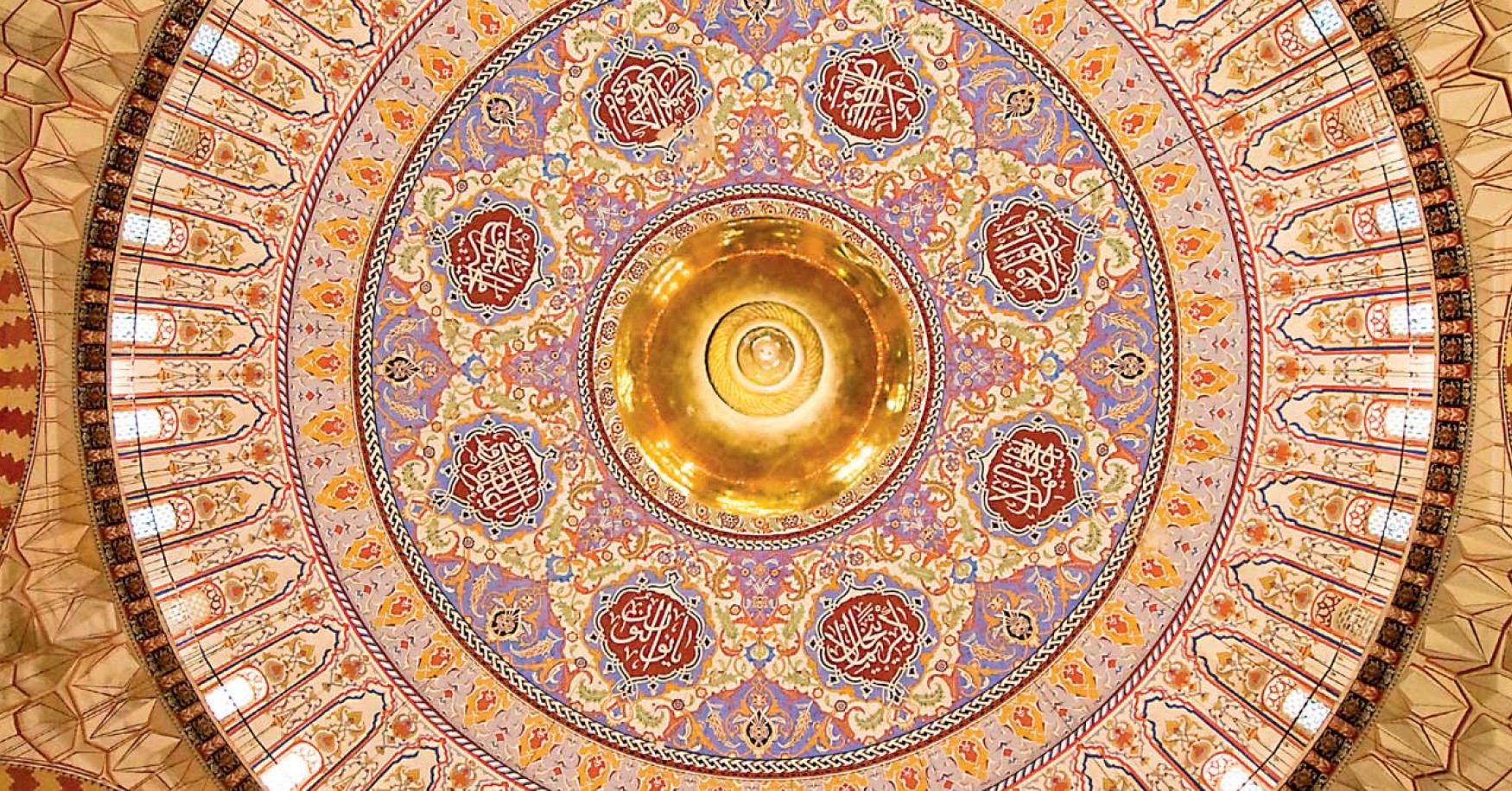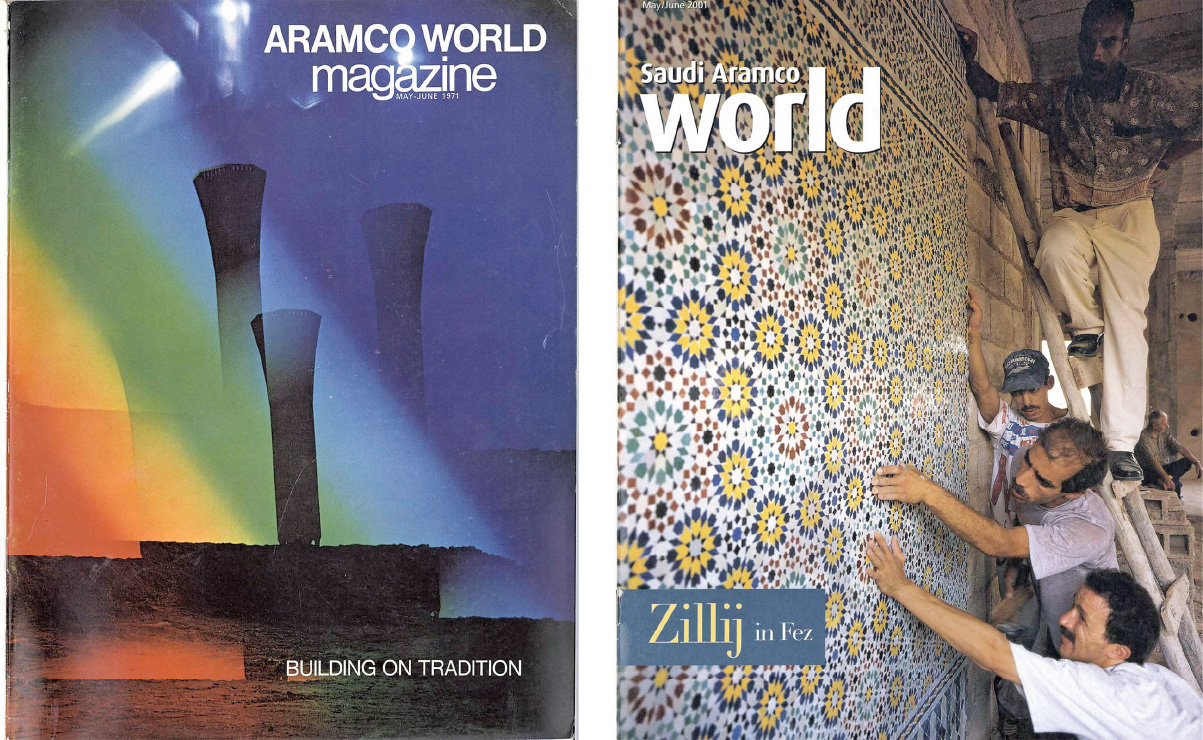
Covering 75 Years of Arts & Culture
- Arts
3
For 75 years AramcoWorld has sought to promote a deeper understanding of the Arab and Muslim world through arts and cultural bridging. That mission has been at the heart of our magazine’s covers.
One poignant example came in 2013, when an AramcoWorld cover featured the dome of the 16th-century Selimiye Mosque. Built in Edirne, Turkey, at the crossroads of the East and West, the Ottoman architectural masterpiece is a synthesis of the Byzantine and Islamic traditions. And the mosque’s ornate dome is regarded as an icon of Islamic art.
Over centuries architecture has created a lasting impact. Moorish architecture in Spain, for instance, not only defined the legacy of Arabs in Europe but stretched to Latin America, as demonstrated in “The Box Balconies of Lima” (2022).
With paintings, illustrations and other visual arts forms, artists explore and interpret the world around them. In the early 1970s, Canadian artist Penny Williams went to Saudi Arabia to paint the Kingdom. Her work “Impressions of Arabia” (1973) was displayed on an AramcoWorld cover that year. “Six Degrees of Suriname” (2015) captured the life and history of a multireligious and multiracial nation through illustrations.
Photographs of performing arts also often found a home on our covers. From “Aida at Luxor” (1987), featuring Guiseppe Verdi’s spectacular opera playing in Egypt, to “Sesame Opens!” (1979), about the Arab equivalent of the American educational television series, the publication has presented a variety of performances that connect us.
Additionally, AramcoWorld has reflected historical cross-cultural connections through music in stories like “The Lutemaker of Brooklyn” (1956) and “Muslim Roots, U.S. Blues” (2006).
Calligraphy has preserved its esthetic and linguistic values in the traditions of the Far East and the Arab world. Those traditions sometimes merged, as we explained in “Shodo Arabi” (2010), in which Japanese artists illustrated their work with Arabic calligraphy.
Through articles about literature and storytellers, the magazine provided insights into histories, cultures and global connections of Arab and Islamic lands. “Gibran Remembered” (1983) highlighted the life and international influence of the famous Lebanese writer Khalil Gibran on the 100th anniversary of his birth.
Above all, the publication has focused on our shared human experiences, values and aspirations through stories about arts and culture. Those stories have largely defined our mission and will continue to do so.

Left to right: November/December 2013, “Domes” (Photo by Tor Eigeland) Ceramics with this transparent, metallic overglaze are called loza dorada (“golden pottery”) in Spanish. The earliest lusterware was created at the beginning of the ninth century CE in Basra and Chuff, in what is now Iraq. Some two centuries later, artisans of Al-Andalus learned enough to start their own production, reaching their apogee of beauty and sophistication in the period of the Alhambra. January/February 2006, “Andalusia’s New Golden Pottery” (Photo by Tor Eigeland)

Left to right:The Great Mosque in Djenné, Mali, built in 1907 on the ruins of an earlier one, is the town’s most important structure and focal point of community pride. Each year townsfolk stage a festival and replaster the mud walls. November/December 1990, “Djenne: Living Tradition” (Photographed by Brynn Brujin) July/August 1993, “Homes of Old Makkah” (Illustration by Bülent Uluengin and Nihal Uluengin) March/April 2008, “East meets West in Venice” (Photo courtesy of Alberto Campanile/CuboImages/Alamy)

January/February 1973, “Impressions of Arabia” (Illustration by Penny Williams)
Architecture shapes a foundation for cultural learning that is shared and admired globally.

First row left to right: January/February 2022, “Behind Lima’s Balcony’s” (Photo by Mariana Bazo) September/October 1987, “A City Within a City” (Photo by Ali A. Mubarak) September/October 1998, “Hearts and Stones” (Photo by Maria Daniels) May/June 1998, “The Masterpiece Minbar” (Photo by Bruce White)

Left to right: May/June 1971, “Building on Tradition” (Photo by B. H. Moody) May/June 2001, “Zillij in Fez” (Photo by Peter Sanders)

Left to right: July/August 1991, “On Culture’s Loom” (Photo by Hermine Dreyfuss); January/February 1989, “Window on the Arab World” (Photo by Bruno De Hogues); May/June 2000, “Lebanon’s Mamluk Movement” (Photo by Richard Doughty); Glassy as evening falls, the waters around the Louvre Abu Dhabi in the United Arab Emirates mirror both sky and the geometry of the museum’s vast, shading dome, whose fractal patterns were inspired by the tradition of Arab screens called mashrabiya. September/October 2018, “A Museum of the World” (Photo by Richard Doughty).

Left: The subway system of Tashkent, Uzbekistan, consists of 29 stations, and each one is designed by an individual artist in honor of cultural heroes or historic resources. July/August 2020, “Tashkent’s Underground Masterpieces” (Photo by Stephen Larry) Right: September/October 2009, “The Tiles of Infinity” (Photo by Peter J. Lu)

Left to right: May/June 2011, “Cool Mideast” (Photo courtesy of Hassan Hajjaj and Rose Issa Projects) September/October 2014, “The Middle East’s New Lenses” (Art courtesy of Camille Zakharia) January/February 1987, “Arab Artists in Italy” (Illustration by Abdel Hakim Abbaci)

Left to right: May/June 2017, “Ambassadors of Art” (Art courtesy of Rashed Al-Shashai) May/June 2009, “Art to Heart” (Photo courtesy of John F. Kennedy Center for the Performing Arts) July/August 2022, “Kingdom of Art” (Photo by Lance Gerber/courtesy of the artist and Desert X AlUla 2022)

September/October 1992, “The Art of Islamic Spain” (Photos courtesy of Metropolitan Museum of Art)

Left to right: November/December 2015, “Stories My Father Told Me” (Illustration by Helen Zughaib) July/August 2015, “Six Degrees of Sunshine” (Illustration by Norman MacDonald) September/October 2024, “The Bridge of Meanings” (Illustration by Amir Pasic)

Left: The illustration depicting cooking and a conversation scene from a men’s encampment was drawn by 11-year-old Imad Jaha from Jiddah, Saudi Arabia, who won a children’s art contest sponsored by Saudi Aramco. November/December 1995, “We Dared to Venture” Illustration by Norman MacDonald Right: November/December 1995, “The Most Splendid Manuscript” Illustration by The Royal Collection

Left: July/August 2023, “Escher + Alhambra = Infinty” (Art courtesy of The M.C. Escher Company) Right: March/April 2010, “Shodo Arabi” (Illustration by Fuad Kouichi Honda)

Left to right: July/August 2007, “New pieces of Mada’in Salih’s Puzzle” (Typesetting by Thomas Milo) March/April 1997, “Letter, Word, Art” (Illustration courtesy of Jordan National Gallery of Fine Arts and Agnes Scott College) September/October 1989, “The Geometry of the Spirit” (Illustration by M. U. Zakariya)

Left: As a boy in Tripoli, Lebanon, Ernest Maliha often sat playing the al’ud, the Arabic name for lute, amid the ruins of a Crusader castle as he looked out over the Mediterranean toward the West where this instrument traveled with the Crusaders seven centuries ago. He then made lutes for more than a half century at his shop in Brooklyn, New York. (Photo by Carl von Hoffman) Right: Latif Al-’Ani was one of Iraq’s most prolific photojournalists. In 1961 he took this photo of a film crew shooting amid the ruins of ancient Babylon. It is part of the personal archive that he placed in the care of the Arab Image Foundation in 2000. And since 1997, the Foundation has gathered more than 15,000 photographs in its Beirut archive and mounted international shows as well. January/February 2001, “The Pictures Between” (Photo courtesy of Arab Image Foundation)

Left to right: July/August 2006, “Muslim Roots, U.S. Blues” (Photo courtesy of Bridgeman Art library) November/December 2023, “A Vocal Appeal to Safeguard Albania’s Iso-Polyphony” (Photo by Ilir Tsouko) May/June 2023, “Rajasthan’s Folk Musicians Find New Ways to Play” (Photo by Poras Chaudhary)

Left to right: March/April 1977, “Choreography in Cairo” (Photo by John Feeney) July/August 1987, “Aida at Luxor” (Photo by Tor Eigeland) November/December 2022, “Tapping into Story” (Photo by Bear Gutierrez) September/October 1979, “Sesame Opens” (Photo by B. H. Moody)

Top left to right: March/April 2005, “Of Stories and Storytellers” (Photo by Lorraine Chittock) March/April 1983, “Gibran Remembered” (Illustration by Norman MacDonald) Bottom left to right: November/December 2003, “Mauritania’s Manuscripts” (Photo by Lorraine Chittock) March/April 1989, “A Nobel for the Arab Nation” (Photo by Thomas Hartwell) January/February 2019, “After Manas, My Kyrgyz, Your Chingiz” (Photo courtesy of the Aitmatov International Foundation)

From kanga, one of the most popular fabrics in East Africa, to muslins of South Asia and the ornate garments and tents of central Asia and the Middle East, over the years AramcoWorld has highlighted the cultural connections between textiles and the communities. Left to right: November/December 1986, “Tentmakers of Cairo” (Illustration by Theresa Le Bas) May/June 2003, “The Soul of Kazakhstan” (Photo by Wayne Eastep) May/June 2016, “Our Story of Dhaka Muslin” (Photo courtesy of DRIK) November/December 2017, “Kanga’s Woven Voices” (Photo by Samantha Reinders)

Left: September/October 2000, “Progress Through Preservation” (Photo by David H. Wells) Right: The first issue to highlight textiles on a cover came in 1953 when the magazine educated readers about carpets and rugs from across Central and East Asia. October 1953, “Oriental Rugs” (Photo courtesy of Metropolitan Museum of Art, inset by T. F. Walters)

Right to left: November/December 2006, “Birmingham 9 to 5” (Photo by Karim Shamsi-Basha) September/October 2004, “Promises and Possibilities: Images of Islam in America” (Photo by Alexandra Avakian) March/April 2019, “The Handwritten Heritage of South Africa’s Kitabs” (Photo by Samantha Reinders)

Left to right: March/April 1993, “Across the High Atlas” (Photo by David Melody) January/February 2003, “Agadez: Sultanate of Sahara” (Photo by Kevin Bubriski) January/February 2008, “Hearts of the New Silk Roads” (Photo by Kevin Bubriski)

For this special issue, AramcoWorld conducted nearly 300 interviews in seven countries—spanning Beirut and Jiddah, Saudi Arabia—to shed light on the lives of women across the Arab world. March/April 1971, “The Arab Woman: An Untypical View” (Photo by Nik Wheeler)

Left to right: March/April 1981, “Formula One” (Photo by Michael Turner) Summer 1972, “Football Arabian Style” (Photo by S. M. Amin) May/June 1986, “Khalifa on the Bat” (Photo by Brian Clark)

Left to right: March/April 2020, “Sepak Takraw Takes Flight” (Photo by Beawiharta) September/October 2003, “History’s Curve” (Photo by David H. Wells) March/April 2016, “Morocco’s New Wave” (Photo by Toni Öyry) March/April 2007, “Doha’s Grand Games” (Photo courtesy of Getty Images)
You may also be interested in...

At Home in the World: A Conversation with Maryam Hassan
Arts
Growing up in London, at age 13, Maryam Hassan decided she’d move to Chicago one day. The city had glittered in her imagination because she was certain that it bore no resemblance to her hometown.
A Life of Words: A Conversation With Zahran Alqasmi
Arts
For as long as poet and novelist Zahran Alqasmi can remember, his life in Mas, an Omani village about 170 kilometers south of the capital of Muscat, in the northern wilayat (province) of Dima Wattayeen, books permeated every part of his world. “I was raised in a family passionate about prose literature and poetry,” Alqasmi recalls.
First Look: The Color of Nubia in Aswan
Arts
As a Saudi photographer with a passion for cultural, human and heritage themes around the world, I strive to make my images windows to the past as well as reflections of the present. When I came across this guesthouse on a visit to Aswan, Egypt, I was taken back to 3000 BCE to ancient Nubia.